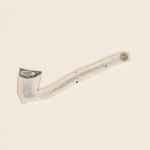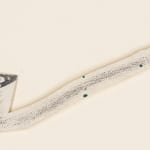



Pablo Picasso
pencil on paper
framed 41 x 46 cm
Further images
Provenance
Estate of the artist
Marina Picasso (the artist’s granddaughter; acquired from the above)
“The goal of the papier collé was to show that different materials can enter into a composition to become, in the picture, a reality, able to compete with nature. We’ve tried to dispense with trompe-l’oeil so as to discover trompe-l’esprit” (Picasso). Picasso established his own, handy collection of paper cut-outs in the shape of pipes, drinking glasses, cups, pears, lightbulbs and other everyday items, which he could collage into cubist café scenes and related still-life compositions, fixing them with dress-making pins, so he could always detach and experimentally reposition them. ‘Pipe Découpé’ has pin-holes in the bowl of the pipe, clearly showing how it was once attached to a paper or canvas support. It may be read as a conventional representation of a pipe, with two apertures and shading along the stem that creates a three-dimensional, sculptural quality. Its cut-out silhouette also figuratively represents a pipe, but the angle of the mouth aperture does not correspond to the conventions of single-point perspective, and it contrasts with the angle at which the bowl of the pipe is viewed. This apparently playful item thus materialises the precepts of cubism, providing simultaneously two different views of a single object, contradicting laws of single-point perspective that had been applied in Western European painting since the early 15th century.
Exhibitions
New York, Paul Rosenberg & Co., The Primacy of Design Major Drawings in Black and Colored Media. From the Marina Picasso Collection, 1983, no. 22, illustrated in the catalogue
Geneva, Galerie Jan Krugier, Picasso, Œuvres cubistes de la collection Marina Picasso, 1986, no. 154, illustrated in the catalogue (with incorrect dimensions)
Publications
New York, Paul Rosenberg & Co., The Primacy of Design Major Drawings in Black and Colored Media. From the Marina Picasso Collection, 1983, no. 22, illustrated in the catalogue
Geneva, Galerie Jan Krugier, Picasso, Œuvres cubistes de la collection Marina Picasso, 1986, no. 154, illustrated in the catalogue (with incorrect dimensions)



